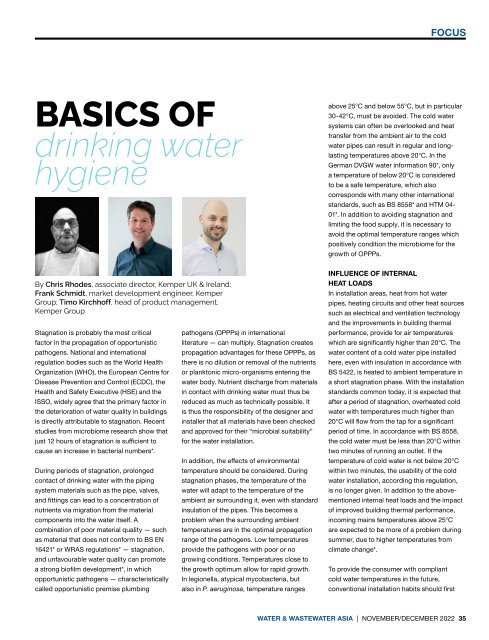Water & Wastewater Asia November/December 2022
Water & Wastewater Asia is an expert source of industry information, cementing its position as an indispensable tool for trade professionals in the water and wastewater industry. As the most reliable publication in the region, industry experts turn this premium journal for credible journalism and exclusive insight provided by fellow industry professionals. Water & Wastewater Asia incorporates the official newsletter of the Singapore Water Association (SWA).
Water & Wastewater Asia is an expert source of industry information, cementing its position as an indispensable tool for trade professionals in the water and wastewater industry. As the most reliable publication in the region, industry experts turn this premium journal for credible journalism and exclusive insight provided by fellow industry professionals. Water & Wastewater Asia incorporates the official newsletter of the Singapore Water Association (SWA).
You also want an ePaper? Increase the reach of your titles
YUMPU automatically turns print PDFs into web optimized ePapers that Google loves.
FOCUS<br />
BASICS OF<br />
drinking water<br />
hygiene<br />
above 25°C and below 55°C, but in particular<br />
30-42°C, must be avoided. The cold water<br />
systems can often be overlooked and heat<br />
transfer from the ambient air to the cold<br />
water pipes can result in regular and longlasting<br />
temperatures above 20°C. In the<br />
German DVGW water information 90*, only<br />
a temperature of below 20°C is considered<br />
to be a safe temperature, which also<br />
corresponds with many other international<br />
standards, such as BS 8558* and HTM 04-<br />
01*. In addition to avoiding stagnation and<br />
limiting the food supply, it is necessary to<br />
avoid the optimal temperature ranges which<br />
positively condition the microbiome for the<br />
growth of OPPPs.<br />
By Chris Rhodes, associate director, Kemper UK & Ireland;<br />
Frank Schmidt, market development engineer, Kemper<br />
Group; Timo Kirchhoff, head of product management,<br />
Kemper Group<br />
Stagnation is probably the most critical<br />
factor in the propagation of opportunistic<br />
pathogens. National and international<br />
regulation bodies such as the World Health<br />
Organization (WHO), the European Centre for<br />
Disease Prevention and Control (ECDC), the<br />
Health and Safety Executive (HSE) and the<br />
ISSO, widely agree that the primary factor in<br />
the deterioration of water quality in buildings<br />
is directly attributable to stagnation. Recent<br />
studies from microbiome research show that<br />
just 12 hours of stagnation is sufficient to<br />
cause an increase in bacterial numbers*.<br />
During periods of stagnation, prolonged<br />
contact of drinking water with the piping<br />
system materials such as the pipe, valves,<br />
and fittings can lead to a concentration of<br />
nutrients via migration from the material<br />
components into the water itself. A<br />
combination of poor material quality — such<br />
as material that does not conform to BS EN<br />
16421* or WRAS regulations* — stagnation,<br />
and unfavourable water quality can promote<br />
a strong biofilm development*, in which<br />
opportunistic pathogens — characteristically<br />
called opportunistic premise plumbing<br />
pathogens (OPPPs) in international<br />
literature — can multiply. Stagnation creates<br />
propagation advantages for these OPPPs, as<br />
there is no dilution or removal of the nutrients<br />
or planktonic micro-organisms entering the<br />
water body. Nutrient discharge from materials<br />
in contact with drinking water must thus be<br />
reduced as much as technically possible. It<br />
is thus the responsibility of the designer and<br />
installer that all materials have been checked<br />
and approved for their “microbial suitability”<br />
for the water installation.<br />
In addition, the effects of environmental<br />
temperature should be considered. During<br />
stagnation phases, the temperature of the<br />
water will adapt to the temperature of the<br />
ambient air surrounding it, even with standard<br />
insulation of the pipes. This becomes a<br />
problem when the surrounding ambient<br />
temperatures are in the optimal propagation<br />
range of the pathogens. Low temperatures<br />
provide the pathogens with poor or no<br />
growing conditions. Temperatures close to<br />
the growth optimum allow for rapid growth.<br />
In legionella, atypical mycobacteria, but<br />
also in P. aeruginosa, temperature ranges<br />
INFLUENCE OF INTERNAL<br />
HEAT LOADS<br />
In installation areas, heat from hot water<br />
pipes, heating circuits and other heat sources<br />
such as electrical and ventilation technology<br />
and the improvements in building thermal<br />
performance, provide for air temperatures<br />
which are significantly higher than 20°C. The<br />
water content of a cold water pipe installed<br />
here, even with insulation in accordance with<br />
BS 5422, is heated to ambient temperature in<br />
a short stagnation phase. With the installation<br />
standards common today, it is expected that<br />
after a period of stagnation, overheated cold<br />
water with temperatures much higher than<br />
20°C will flow from the tap for a significant<br />
period of time. In accordance with BS 8558,<br />
the cold water must be less than 20°C within<br />
two minutes of running an outlet. If the<br />
temperature of cold water is not below 20°C<br />
within two minutes, the usability of the cold<br />
water installation, according this regulation,<br />
is no longer given. In addition to the abovementioned<br />
internal heat loads and the impact<br />
of improved building thermal performance,<br />
incoming mains temperatures above 25°C<br />
are expected to be more of a problem during<br />
summer, due to higher temperatures from<br />
climate change*.<br />
To provide the consumer with compliant<br />
cold water temperatures in the future,<br />
conventional installation habits should first<br />
WATER & WASTEWATER ASIA | NOVEMBER/DECEMBER <strong>2022</strong> 35


















